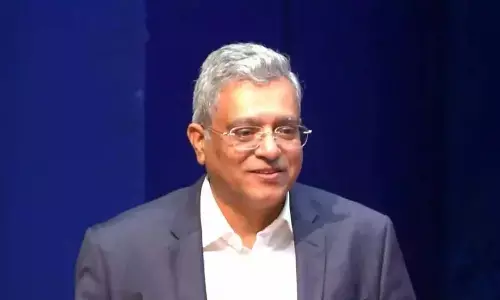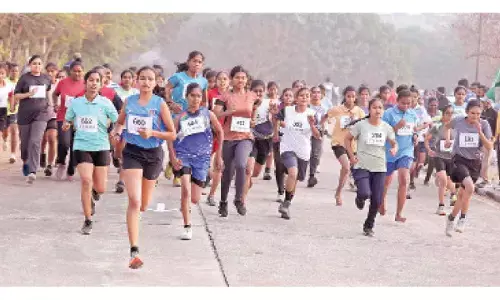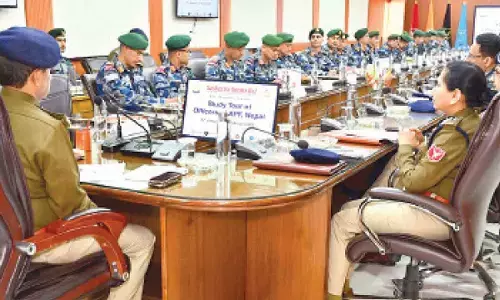Safeguarding the interests of farmers

Transformational changes are taking place in India currently, improving the way we live. These changes are impacting all our lives in small or significant ways. It is gratifying to know that the citizens at large are happy with these changes. The technology and policy are working together to remove discretion and opaqueness.
Transformational changes are taking place in India currently, improving the way we live. These changes are impacting all our lives in small or significant ways. It is gratifying to know that the citizens at large are happy with these changes. The technology and policy are working together to remove discretion and opaqueness.
The on-going discourse on the Public Distribution System (PDS), the procurement of grains/pulses from farmers, public storage in Food Corporation of India godowns, commitments made in the World Trade Organization (WTO), Direct Benefit Transfer, etc. is interesting. It is also necessary to infuse facts into the discourse.
What is the effect on the State exchequer on account of subsidy given under National Food Security Act?
• Since the central issue price under the NFSA is much lower compared to the erstwhile Targeted Public Distribution System (for instance, in case of Tamil Nadu state) the burden on the State government has come down.
• On implementing the NFSA, the savings for the State exchequer on account of this subsidy, thanks to thelower central issue price.
Background:
• The Centre had recently warned of action if Kerala and Tamil Nadu failed to implement the National Food Security Act (NFSA) and had said if there was no immediate improvement in the situation, foodgrains for distribution to above poverty line (APL) families in these states will be provided at a higher rate. So far, the central government has been able to implement the NFSA in 34 states and union territories.
National Food Security Act
• The National Food Security Act, 2013 (also Right to Food Act) is an Act of the Parliament of India which aims to provide subsidized food grains to approximately two thirds of India’s 1.2 billion people.
• The National Food Security Act, 2013 (NFSA 2013) converts into legal entitlements for existing food security programmes of the Government of India.
• It includes the Midday Meal Scheme, Integrated Child Development Servicesscheme and the Public Distribution System.
• Further, the NFSA 2013 recognizes maternity entitlements.
• The Midday Meal Scheme and the Integrated Child Development Services Scheme are universal in nature whereas the PDS will reach about two-thirds of the population (75% in rural areas and 50% in urban areas).
• Under the provisions of the bill, beneficiaries of the Public Distribution Systemare entitled to 5 kilograms per person per month of cereals at the following prices:
o Riceat Rs 3 per kg
o Wheatat Rs 2 per kg
o Coarse grains (millet) at Rs 1 per kg.
• Pregnant women, lactating mothers, and certain categories of children are eligible for daily free cereals.
Salient features:
• Under the act, 75% rural and 50% of the urban population are entitled for three years from enactment to five kg food grains per month at 3 Rupees , 2 Rupees, 1 Rupee per kg for rice, wheat and coarse grains (millet), respectively.
• The states are responsible for determining eligibility.
• Pregnant women and lactating mothers are entitled to a nutritious “take home ration” of 600 Calories and a maternity benefit of at least Rs 6,000 for six months.
• Children 6 to 14 years of age are to receive free hot meals or “take home rations”.
• The central government will provide funds to states in case of short supplies of food grains. The state government will provide a food security allowance to the beneficiaries in case of non-supply of food grains.
• The Public Distribution System will be reformed under the act.
• There will be state- and district-level redress mechanisms and State Food Commissions will be formed for implementation and monitoring of the provisions of the Act.
• The poorest that are covered under the Antodaya yojana will remain entitled to the 35 kg of grains allotted to them under the mentioned scheme.
Analysis
• The minimum PDS entitlement under the Act is roughlyhalf of an average person's food grain requirements. It is not much. But in a drought situation, even this minimum entitlement can go a long way in averting hunger. Thus, India has a lasting infrastructure of public support that can, in principle, be expanded in drought years to prevent hunger and starvation.
• Towards the end of 2015, reports from Bundelkhand in Uttar Pradesh, were most alarming. A rapid survey conducted by NGO Swaraj Abhiyan, found evidence of famine-like conditions developing in the area. To illustrate, 38% of the sample villages reported at least one death due to starvation ormalnutrition in the preceding eight months.
• This survival crisis has a lot of to do with UP's failure to implement the National Food Security Act (NFSA) in good time. Had NFSA been operational in Bundelkhand, more than 80% of the rural population would be covered under an improved Public Distribution System (PDS).
• Among other remarkable improvements is thetransparency of the entire process. In most states, the list of NFSA ration cards is available on the Net in a reader-friendly format, with all requisite details. That makes it a lot harder to cheat — gone are the days when the village head dished out BPL cards to his or her friends without any risk of scrutiny.
• The NFSA came into force in the second half of 2013. But its implementation by most of the States delayed by one to three years and some states like Kerala and Tamil Nadu are still pending it. Thus, the issue hasinvited strong criticism from many sides.
• For instance the Act was implemented in Gujarat only by this April (2016) and it had to face a PIL petition before the above said time for its non-implementation of the Act.
• The PIL petition was filed in the High Court demanding compensation from Gujarat for its failure to implement the law, which is likely to benefit almost 3.8 crore people in the State.
• And the Supreme Court had also slammed Gujarat and some other state governments who were not implementing the National Food Security Act and raised questions on how could a state defy a Central welfare legislation.
• Implementation in some of the states was started hurriedly without completing all the requisite preparations. Consequently, problems were faced.Uttarakhand had to roll back the implementation andBihar also faced initial problems in distribution.
• The biggest challenge, responsible for the delayed rollout of NFSA in many States, was to identify eligible households. The delay in the implementation of NFSA in some States/UTs wasblamed on non-finalisation of figures under Socio Economic Caste Census, lack of infrastructural facilitiesand insufficient funds and manpower.
• The Centre has managed to get these two States to agree to the implementation of the Act from November 1,2016. The States says it will implement the Act and also continue its universal PDS coverage. In the bargain, it will have to maintain a uniform supply of 5 kg of rice per person as stipulated in the NFSA, and protect the existing entitlements of PDS beneficiaries.
• The resultant increase in offtake would result in additional expenditure of Rs.1,193 crore for Tamil Nadu. Kerala maintains an APL-BPL distinction in its PDS. However, its concerns over the implementation of the Act related to the possibility that many beneficiaries may be left out under the Centre’s categorisation of PDS consumers into ‘priority households’ and others.
• The NFSA, by imposing its formula on everyone, alsothreatens to upset the applecart(to spoil plans or arrangements) of States such as Tamil Nadu, Chhattisgarh and Kerala that are doing a decent job of implementing their sui generis model of PDS. Theregional successes seem to depend on a combination of factors such as a simpler distribution model, and on specific schemes such as community kitchens and mid-day meal programmes.
• One clear advantage of joining the national food security system now is that the computerisation and Aadhaar seeding process may result in the elimination of bogus cards and beneficiaries. Tamil Nadu’s case for such a clean-up is glaring as the number of people covered by its family cards is about 7.81 crore while the State’s population is 7.21 crore.
• Before the Act came into force, barely one-fourth of the rural population in Uttar Pradesh benefited from the PDS under the “below poverty line” (BPL) category. The rest received nothing as the “above poverty line” (APL) quota was routinely sold in the open market by corrupt middlemen. Further, even BPL cards were often in the wrong hands.
• The NFSA is a chance for the government of U.P. to clean up this mess and cover 80 per cent of the rural population under an improved PDS, as many of the poorer States have already done to a large extent.
• The worst reports of food deprivation used to come fromUttar Pradesh, which is nowhere near implementing the NFSA. No Indian State has more to gain than U.P. from the NFSA.
• The new list, based on the Socio Economic and Caste Census 2011 (SECC), is not only more inclusive than the BPL list, it is also more reliable. Even then, some poor households are off the list of ration cards, possibly because the SECC missed them, or because they were formed after 2011, or for some other reason.
There are many cases of ration cards with missing household members. This matters since PDS entitlements are defined in per capita terms under the NFSA. Also, the new list of ration cards includes fewer Antyodaya households than the old list, a problem that has also emerged in other States. It will take skilful revision of the NFSA list to resolve these problems.
• Only half of the targeted beneficiaries under the National Food Security Act (NFSA) have been identified by States and Union Territories so far, according to an audit by the Comptroller and Auditor General of India.Old databases of beneficiaries are still in use in these regions, the CAG found. It has directed the Centre to assure itself that the States/UTs have identified beneficiaries by following transparent processes before allowing them revised and enhanced entitlements.
Benefits
• As a result, now 81.34 crore persons will get wheat at Rs. 2 kg and rice at Rs. 3 kg.
• At this current coverage, monthly allocation of foodgrains to States/UTs under the Act is about 45.5 lakh tons, with subsidy implication of about Rs. 11,726 core per month or about Rs. 1,40,700 crore per year.
Reforms in PDS
• Now the Centre will focus on further reforms in PDS, which will include end to end computerization of the system for which States/UTs are being technically and financially assisted.
• This is important for bringing in transparency in the functioning of the Public Distribution System (PDS), which is vital feature of NFSA, in order to check leakages and diversion of foodgrains.
Current status
• The beneficiary’s data base has been digitized in all the 36 States/UTs, wherein, information is available right upto beneficiary level and is in the public domain.
• Online allocation of foodgrains in being done in 28 States/UTs, and the entire foodgrain supply chain has been computerized in 18 States/UTs.
• 100 percent linkage of Ration Cards with Addhar, which is 71% at the moment, will be achieved.
• Foodgrains losses of FCI have been brought down to 0.04 percent and major FCI depots have been made online.
Direct benefit transfer
• In another significant step towards better targeting and leakage-free distribution of foodgrains, direct benefit transfer is being carried out in two different modes. In the first mode, food subsidy is being transferred in cash into the bank account of beneficiaries, who then have the choice to buy foodgrains from the open market. This has been started in UTs of Chandigarh, Puducherry and urban areas of Dadra & Nagar Haveli.
• The second mode involves automation of fair price shops, for distribution of foodgrains through an electronic point of sale (e-PoS) device which authenticates beneficiaries at the time of distribution and also electronically captures the quantum of foodgrains distributed to the family. As of 31 October 2016, e-PoS devices are operational in 1,61,854 fair price shops.
Central assistance to state governments
• For smooth functioning of PDS, State Governments are also being provided Central assistance for meeting expenditure of intra-State transportation & handling of foodgrains and fair price shop dealer’s margin. The assistance for fair price shops dealers margin also contains a component of assistance for installation and operation of PoS devices at fair price shops. So far, Rs. 1874 crore has been released to State Governments.
Challenges ahead:
• Food grains under the act will be distributed through the already existing PDS (Public Distribution System). But, these PDSs have many loopholes such as leakages of food grains, corruption etc.
• The exact number of poor is not calculated correctly. Different departments are giving different numbers.
• The cost of this bill, Rs.1.24 lakh crore will be a burden for the government, and may lead to fiscal deficit.
• As most of the food grains will be procured by Govt, exports will reduced, which is a big threat to the economy.
• Small farmers may shift to other crops, as they may get the subsidized food grains. This may reduce the production of food grains.
Government has made it mandatory to have an Aadhaar number for availing benefits under the National Food Security Act (NFSA).
• The centre issued a notification under the Aaadhar (Targeted Delivery of Financial and Other Subsidies, Benefits and Services) Act, 2016, which requires over 800 million beneficiaries to furnish their Aadhaar numbers to avail subsidized food.
• So far, about 72% of beneficiary households have linked their ration cards with the Aadhaar number.
• Those without Aadhaar have to enrol by June
• those without an Aadhaar number will have to furnish proof to the effect that they have applied for one to receive subsidized food.
• Currently state including Andhra Pradesh, Gujarat, Karnataka, Rajasthan, Tamil Nadu, Delhi and Maharashtra have committed to boost digital transaction systems in their ration shops by March.
• A provision has been made that any member of eligible household listed in the ration card would be entitled to get the entire quota of subsidised foodgrains or cash transfer of food subsidy, if any one member of the household in the ration card fulfils the identification conditions in case Aadhaar is not yet assigned to all such members of the household.
• The use of Aadhaar as identity document for delivery of services or benefits or subsidies simplifies the delivery processes, brings in transparency and efficiency and enables beneficiaries to get their entitlements directly in a convenient and seamless manner.
• “Aadhaar Act, inter alia, provides that the Central/State government while making expenditure from Consolidated fund of India for any subsidy, may require such individual to furnish proof of possession of Aadhaar number or undergo authentication
• In case there is no Aadhaar enrolment centre located in the respective block or taluka or tehsil, States are required to provide enrolment facilities at convenient locations in coordination with the UIDAI or the existing Registrars of UIDAI or by becoming UIDAI registrar themselves.
MSP vs Central issue price
• Minimum Support Price (MSP) is the price at which central government procures the food grains from farmers. Central Issue Price (CIP) is the price at which government makes these food grains available to states. The states fix retail price to be charged at fair price shops.
• Procurement, storage, transportation of food grains. Procurement is done at Minimum Support Prices.
• Bulk allocation of food grains to the State Governments, which in turn deliver the same to recipients. This is done at Central Issue Price (CIP)
How can Trade Facilitation Agreement be seen about facilitating and bringing trade transparency?
• The Trade Facilitation Agreement was agreed on in 2013 in Bali and came into force from February 2017after two-thirds of the WTO’s 164 members ratified it.
• Several trade-related issues such as transparency,predictability and efficiency at the ports, faster clearance procedures, and improved appeal rights for traders are to be addressed by countries.
• They shall notify various provisions to bring in the facilitation, over three years or more.
• Only the basic set of provisions will be implementedwithin one year.
• The Trade Facilitation Agreement allows for consultations before any new trade rules are notified.
• A WTO study indicated that when the Trade Facilitation Agreement is fully implemented, trade costs for member countries will decrease by an average of 14.3%.
• It is also estimated that the time taken to export and import will come down drastically.
• Budgetary allocations are made for bringing in single-window clearance and improving customs clearance at the ports.
• A high-level committee chaired by the Cabinet Secretary will monitor logistics and efficiency at ports and related issues.
• Thus, it can be seen that the Trade Facilitation Agreement is not about market access but inter alia about facilitating and bringing trade transparency.
What is the unresolved Public Stock Holding issue at the WTO?
The Public Stock Holding issue remains unresolved at the WTO.
• Although agreed on in Bali in 2013 and reiterated in Nairobi in 2015, that a permanent solution for Public Stock Holding be found by 2017, it is still a ‘work-in-progress’.
• The existing WTO rules would have allowed a legal challenge to our Public Stock Holding and minimum support price-based procurement programme in case we breached ‘the limit’ on procurement.
• ‘The limit’ is defined as 10% of the value of production of the particular grain being procured.
• WTO rules classify procurement and holding of public stocks for food security purposes as ‘Green Box’ or non-trade distorting.
What is considered as trade-distorting under WTO rules and how Peace clause will give immunity?
• If food grains for the public stocks are procured through an administered price/minimum support price and if this minimum support price is higher than the archaic fixed reference price (calculated on base period 1986-88), then it is considered as trade-distorting agriculture support.
• Such trade-distorting support should be within ‘the limit’, which is 10% of the value of production of the particular grain being procured. This is also called as Peace clause.
• One of the first things that this government did in 2014 was to intensely engage with the WTO to obtain a ‘peace clause’ so that even if we did breach ‘the limit’, no one shall challenge our programme till such a time a permanent solution is found, agreed on, and adopted by the WTO membership.
• By November 2014 we obtained an open-ended peace clause from the General Council of the WTO, which was later reaffirmed at the Nairobi Ministerial andsafeguarded the interests of the farmer and ensured that India’s sovereign right to protect them is not diluted.
By Gudipati Rajendera Kumar

















